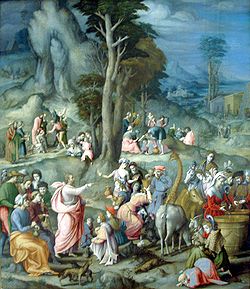
Francesco Bacchiacca
Encyclopedia

Italy
Italy , officially the Italian Republic languages]] under the European Charter for Regional or Minority Languages. In each of these, Italy's official name is as follows:;;;;;;;;), is a unitary parliamentary republic in South-Central Europe. To the north it borders France, Switzerland, Austria and...
painter of the Renaissance
Renaissance
The Renaissance was a cultural movement that spanned roughly the 14th to the 17th century, beginning in Italy in the Late Middle Ages and later spreading to the rest of Europe. The term is also used more loosely to refer to the historical era, but since the changes of the Renaissance were not...
whose work is characteristic of the Florentine Mannerist
Mannerism
Mannerism is a period of European art that emerged from the later years of the Italian High Renaissance around 1520. It lasted until about 1580 in Italy, when a more Baroque style began to replace it, but Northern Mannerism continued into the early 17th century throughout much of Europe...
style.
Bachiacca was born and baptized in Florence on March 1, 1494 [modern] and died there on October 5, 1557. He apprenticed in Perugino's Florentine studio, and by 1515 began to collaborate with Andrea del Sarto
Andrea del Sarto
Andrea del Sarto was an Italian painter from Florence, whose career flourished during the High Renaissance and early Mannerism. Though highly regarded during his lifetime as an artist senza errori , his renown was eclipsed after his death by that of his contemporaries, Leonardo da Vinci,...
, Jacopo Pontormo and Francesco Granacci
Francesco Granacci
Francesco Granacci was an Italian painter of the Renaissance.Born at Villamagna di Volterra, he trained in Florence in the studio of Domenico Ghirlandaio, and was employed painting frescoes for San Marco on commission of Lorenzo de'Medici...
on the decoration of cassone (chest), spalliera (wainscot), and other painted furnishings for the bedroom of Pierfrancesco Borgherini and Margherita Acciauoli. In 1523, he again participated with Andrea del Sarto, Franciabigio
Franciabigio
Franciabigio was an Italian painter of the Florentine Renaissance. His true name may have been Francesco di Cristofano, however he also is referred to as either Marcantonio Franciabigio or Francia Bigio....
and Pontormo in the decoration of the antechamber of Giovanni Benintendi. While he established a reputation as a painter of predellas and small cabinet pictures, he eventually expanded his output to include large altarpieces, such as the Beheading of St. John the Baptist, now in Berlin.
In 1540, Bachiacca became an artist at the court of Duke Cosimo I de' Medici (reg. 1537-1574) and Duchess Eleanor of Toledo. In this capacity, Bachiacca was a colleague and peer of the most important Florentine artists of the age, including Pontormo, Bronzino, Francesco Salviati
Francesco Salviati
Francesco Salviati may refer to:* Francesco Salviati , archbishop of Pisa, involve in the Pazzi Conspiracy* Francesco de' Rossi , Mannerist artist...
, Tribolo, Benvenuto Cellini
Benvenuto Cellini
Benvenuto Cellini was an Italian goldsmith, sculptor, painter, soldier and musician, who also wrote a famous autobiography. He was one of the most important artists of Mannerism.-Youth:...
, Baccio Bandinelli, and his in-law Giovanni Battista del Tasso. Bachiacca's first major commission was to paint the walls and ceiling of the duke’s private study with plants, animals and a landscape, which remain an important testimony of Cosimo's interest in botany and the natural sciences. Bachiacca also made cartoons for two series of tapestries, the Grotesque Spalliere (1545–49) and the Months (1550–1553), which were woven by the newly-founded Medici tapestry works. Francesco signed only one known work, the decoration of a Terrace for the duchess and her children, with his abbreviated Christian name and nickname: "FRANC. BACHI. FACI." All of these works either contain carefully observed illustrations of nature or display the artist's trademark method and style, in which Bachiacca combines figures, exotic costumes and other motifs acquired from Italian artists and German and Netherlandish prints into entirely new compositions. These cosmopolitan assemblages exhibited the most praiseworthy elements of both northern and southern European Renaissance art, which appealed to their courtly clientele.
Bachiacca belonged to a family of at least five, and possibly as many as eight artists. His father Ubertino di Bartolomeo (ca. 1446/7-1505) was a goldsmith, his older brother Bartolomeo d’Ubertino Verdi (aka Baccio 1484-c.1526/9) was a painter, and his younger brother Antonio d’Ubertino Verdi (1499–1572)—who also called himself Bachiacca—was both an embroiderer and painter. Francesco’s son Carlo di Francesco Verdi (-1569) painted and Antonio’s son Bartolomeo d’Antonio Verdi (aka Baccino -1600) worked as an embroiderer. This latter generation probably continued to produce paintings and embroideries after Bachiacca's death and until the Verdi family extinguished about the year 1600.
His works include:
- Predella with the Life of St. Achatius and the Ten Thousand Martyrs (1521, Uffizi Gallery) http://www.polomuseale.firenze.it/inv1890/scheda.asp
- The Gathering of Manna (1540/1555)
- Deposition (Uffizi Gallery)

